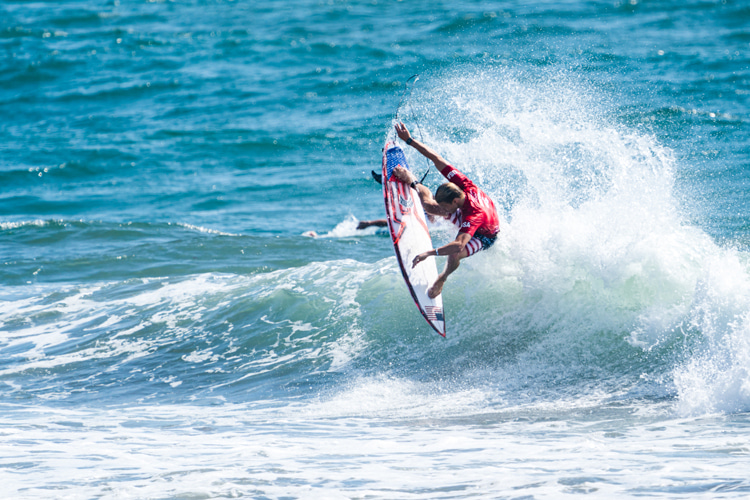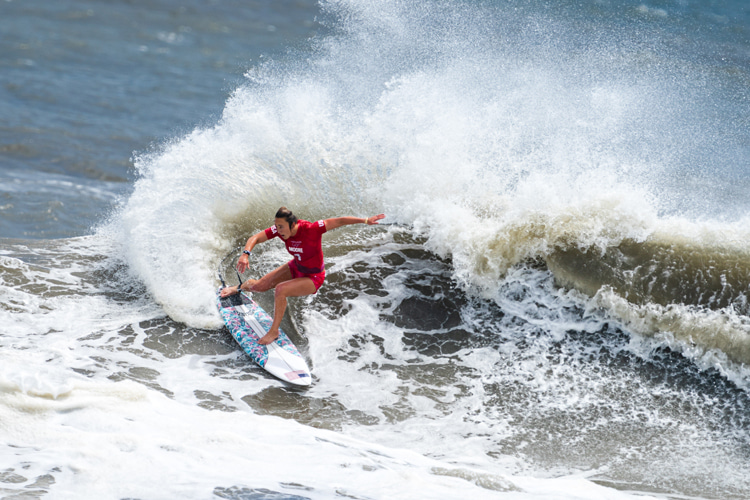Surfing's debut on the world's largest sporting stage - the 2020 Olympic Games - may be over, but the memories and impact continue.
Over the last several weeks, we've talked to many of you and reflected on the legacy of surfing's first Olympics and what we can improve in Paris 2024.
Here are our top ten takeaways from surfing's Olympic debut:
1. Carissa Moore is powerful in and out of the water
After ripping through tricky typhoon conditions to make the final and clinch the gold medal, Carissa put in marathon days of media interviews, appearances, and sponsor promotions, answering every question with the utmost poise and passion.
She said the Olympic platform gives her the opportunity to help new audiences fall in love with surfing, inspire girls to follow their dreams, and share Hawaii's Aloha spirit.
2. The "first, firsts" will live in infamy
Immense gratitude for the perseverance and wisdom of International Surfing Association's President Fernando Aguerre for seeing Duke's dream through to make surfing's first Olympic Games a reality.
Surfing's Olympic debut was made even more extraordinary by the time, place, and people.
After a year's delay and plenty of international strife and division, the world came together around sport, and surfing got to add its Aloha spirit into the mix.
While it was heartbreaking to leave family and friends behind, the COVID restriction created a unique opportunity for team bonding, focus, a tight-knit Olympic family, and cherished memories.
3. The Olympic stage is big
Viewership numbers were down over prior Olympic Games but still beat competitor broadcast shows every night of the Games.
Carissa Moore's gold medal press conference alone reached 10,000-plus media outlets serving billions of people around the world.
Features about surfing were carried on media channels that had never covered surfing before.
4. Japan was a superb host and a fabulous tourist destination
Pre-Olympic Games training camp host city Makinohara offered the finest food, hospitality, and accommodations to help the team acclimate and warm up for surfing's Olympic debut.
At the Games, the team house Pension Third Place and the Chiba community gave the team gold medal support, in true Japan's omotenashi spirit - which means to wholeheartedly look after guests.
Both communities are already getting bookings for those who want to stay where Team USA Olympic surfers stayed.

5. Brett Simpson was the perfect coach for the job
Brett's humble, authentic sense of purpose was the best possible match for surfers who were already at the top of their games.
He knew just what to focus on and what to leave alone.
Growing up with an NFL football player father, Brett respected the talent of each surfer and understood the value of the team.
Brett spent a lot of time studying the Olympic venue's wave conditions and what made surfers successful in those conditions.
Carissa Moore said Brett's positioning calls made a huge difference in her gold medal heat.
Knowing where to sit, take off, finish the wave, paddle back out for position, and maximize time and priority were key difference makers in 2021 Olympic surfing.
6. Reporters were excited about surfing and surfers
In-depth feature stories showed the world how fun, smart, and interesting Team USA's surfers are.
Sports Illustrated reported on Kolohe Andino's encyclopedic knowledge of sports, deep read of wave reports, strong convictions, and work ethic.
The same reporter offered a nuanced view of Carissa Moore's Aloha spirit and love for the United States and Hawaii.
A Washington Post interactive feature of Caroline Marks described what makes her surfing so special, and NBC highlighted the influence of her big, wonderful family.
Men's Health and GQ showed John John Florence's sense of adventure and superhuman comebacks from injury.
7. The appeal is real, and it's only the beginning
If people were intrigued by typhoon storm surf in Chiba, just wait until they see barreling, treacherous Teahupo'o in the 2024 Olympic Games.
New audiences gained respect and appreciation for the courage, fitness, and athleticism Olympic surfers displayed, paddling out in roiling, overhead conditions and finding wave faces with scoring opportunities.
Each surfer brings their own style and interpretation to the unfurling canvas of the wave, making surfing wildly entertaining.
8. The NBC Olympic broadcast production was next level, but the delivery was frustrating
There were more cameras and microphones in more interesting places than surfing has ever known before, offering audiences an immersive experience.
But audiences struggled to know how, where, and when to tune in.
Most of the surfing competition was available through streaming, which required a subscription after 30 minutes and had a different set of commentators than the primetime broadcast.
The display of scores left many confused about the score surfers needed to advance or move into first.
We're hoping the experience leads to improvements in the 2024 Olympic Games.
9. The obsessive cynicism about poor wave conditions was not shared by those doing the surfing
Surfers embraced the opportunity to take on new and different wave conditions.
John John Florence said he enjoyed the challenge of generating speed in smaller beach break conditions.
In an interview, he shared: "It's a totally different kind of surfing and a fun challenge for me."
John's response shows the kind of mindset that the best competitors have - relentless curiosity and excitement about possibilities allow surfers to see and take opportunities others just don't.
10. Two weeks of Olympic Games competition required years of preparation
Team USA surfers stayed in some of the best accommodations in Japan, with support services and expertise to help them perform at their best.
CEO Greg Cruse and the US Olympic and Paralympic Committee Japan liaison Jon Omori started finding hotels, healthy food sources, and equipment in 2017, cultivating the relationships and local support needed to ensure surfers had the best possible Olympic experience.
The planning and preparation proved even more important for a COVID-19 Olympics.
Meeting COVID-19 protocol requirements to stay eligible to compete was intense but made considerably more effective by staying in our own bubble prior to and during the Games.
USA Surfing | Tokyo 2020 Olympic Numbers
However, you do the math. Surfing's first Olympic Games was epic.
Here are a few of our favorite numbers illustrating the impact and support behind Team USA's first Olympic Games.
- 31.8 million people were reached by news and broadcast stories about Team USA surfers;
- 10,000 plus worldwide media outlets accessed Carissa Moore's gold medal press conference;
- 715 kilograms of ice;
- 660 Instagram Stories;
- 560 eggs;
- 312 barbecued baby back ribs;
- 280 electrolyte packets;
- 245 Covid-19 temperature checks;
- 215 Covid-19 tests;
- 150 homemade popsicles;
- 130 avocados;
- 130 USA Surfing social media posts;
- 100 heads of lettuce;
- 80-plus Hydro Flask bottles in multiple sizes for hydration;
- 70 ice baths;
- 70-plus hours of physical therapy;
- 40 pounds of carrots;
- 40 cases of blue diamond almonds;
- 20 pounds of bacon;
- 10 whole fillet mignon cut into steaks;
Words by USA Surfing
